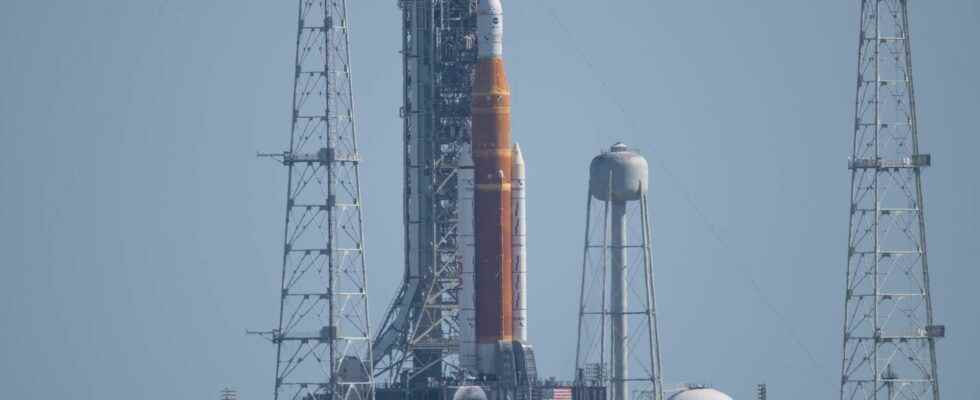NASA which is preparing for a new launch chronology rehearsal attempt with filling of the SLS launcher (WDR, Wet Dress Rehearsal) is also preparing the Artemis I mission which will be carried out during the inaugural flight of the SLS. Artemis I, which should pave the way for the return of Americans to the Moon by 2028, could be launched during the summer. But on what date? Surprisingly, despite the Moon’s proximity to Earth, launch opportunities aren’t as plentiful as one might think. Explanations.
If the second attempt to repeat the launch timeline with filling of the launcher SLS (WDR, Wet Dress Rehearsal) is going well, the Nasa and Boeing are then expected to ramp up on preparation for the SLS’s maiden flight on the Artemis I mission at a date yet to be announced. But, finding a launch date is a bit of a headache because The NASA must take into account several parameters.
A coaster around the moon
As a reminder, Artemis I will consist of an unmanned test flight around the Moon following a trajectory similar to that of the mission Apollo 8, using lunar gravity to gain speed and to propel itself nearly 70,000 kilometers beyond the Moon, nearly half a million kilometers from Earth – farther than any human has ever travelled. On his return trip, Orion will perform a overview from the Moon before returning to Earth. The mission will last about 20 days and will end with a dip in the Pacific Ocean without the service module which will be separated from the vehicle and burn in theatmosphere.
The uncertainty about the launch date of this mission is not only explained by the end date of the WDR tests and the fire green when using SLS. There are a whole bunch of other parameters to take into account. Indeed, surprisingly, despite the very close proximity of the Moon to the Earthwithin the framework of this mission the launch opportunities are not as numerous as one might think.
These Windows of shooting mainly take into account the mechanics orbital involved in launching on a precise trajectory to the Moon as the Earth rotates on its axis and the Moon rotates around the Earth every month in its lunar cycle. But not only.
Four main parameters that will determine the launch date
Unsurprisingly, the launch date must take into account the position of the Moon so that the upper stage of the SLS launcher can program the combustion of translunar injection with sufficient performance to intercept the “ramp” to theorbit retrograde lunar. In the future, this stage will be replaced by the EUS Exploration Upper Stage (Upper Stage Exploration) more powerful, which will allow almost daily, or even daily, launches to the Moon, depending on the desired orbit. In addition, the resulting trajectory for a given day must guarantee thatOrion does not remain in the dark for more than 90 minutes at a time, so that its solar panels can receive and convert the light from Sun in electricity and that the spacecraft can maintain an optimal temperature range. Finally, the launch date must allow a return trajectory which authorizes the entry technique, called by jump. This technique consists of a maneuver during which the spacecraft dives into the upper part of the Earth’s atmosphere and uses this atmosphere, as well as the lift from the capsule, to simultaneously slow down and exit the atmosphere, then return for the final descent and splashdown. This technique allows engineers to accurately determine the location of Orion’s splashdown and, on future missions, will help reduce the aerodynamic failure loads experienced by aircraft. astronauts inside the vessel and to keep the structural loads of the vessel within the design limits. Finally, the launch date must allow Orion to be splashed down during the day, to help recovery personnel locate, secure and recover the spacecraft in the Pacific Ocean.
Taking into account all these parameters and constraints, NASA has identified and determined 73 potential launch dates between July 26 and December 23, 2022. This results in a schedule with approximately two weeks of launch possibilities, followed by two weeks without launch possibilities.
Firing windows considered for Artemis 1
July 26 – August 10
- 13 launch opportunities
- No launch possibility on August 1, 2 and 6
August 23 – September 6
- 12 launch opportunities
- No possibility of launching on August 30 and 31 as well as the 1er september.
September 20 – October 4
- 14 launch opportunities
- No possibility of launching on September 29.
October 17 – October 31
- 11 launch opportunities
- No possibility of launch on October 24, 25, 26 and 28
November 12 – November 27
- 12 launch opportunities
- No possibility of launch on November 20, 21 and 26
December 9 – December 23
- 11 launch opportunities
- No possibility of launch on December 10, 14, 18 and 23
Special offer: for Father’s Day, offer the best of Science!
Your father is a great science enthusiast and unusual discoveries? And if you offer him a superb scientific exploration in paper format? Benefit from -20% on the Mag Futura (special offer: €15 instead of 19 €): 220 pages to explore 4 scientific issues that will shape our future!
Mag Futura is:
- 4 major scientific questions for 2022, from the Earth to the Moon
- 220 pages, 60 experts: no fake news, just science
- Home delivery with electronic gift card
- An independent scientific media
Interested in what you just read?
